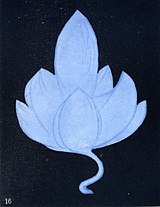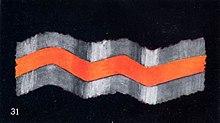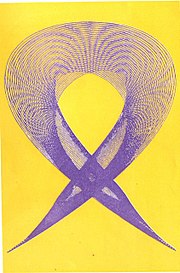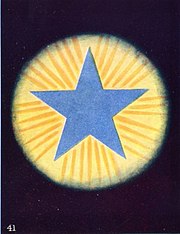5 de enero de 2020
Thought-Forms (book)
From Wikipedia, the free encyclopedia

2nd reprint title page, 1905
| |
| Authors | A. Besant, C. W. Leadbeater |
|---|---|
| Country | United Kingdom |
| Language | English |
| Subject | Theosophy |
| Publisher | Theosophical Publishing Society |
Publication date
| 1901 |
| Pages | 84 |
| OCLC | 59773169 |
| Text | Thought-Forms online |
Thought-Forms: A Record of Clairvoyant Investigation is a theosophical book compiled by the members of the Theosophical Society A. Besant and C. W. Leadbeater. It was originally published in 1901 in London.[1][2] From the standpoint of Theosophy, it tells regarding visualization of thoughts, experiences, emotions and music. Drawings of the "thought-forms" were performed by painters Varley, Prince, and McFarlane.[3][note 1]
Contents
From history of compilation[edit]
This book has become the result of the joint work of the authors, which began in 1895, when they had started an investigation of "the subtle matter of the universe."[8] They were interested the work of the human mind as, according their claim, this work "extrudes into the external world" the thought-forms.[9]
In September 1896, Besant reported in Lucifer that "two clairvoyant Theosophists" (whose personalities were not disclosed in the journal, although some members of the Society knew about them) had started "observing the substance of thought." Her article named Thought-Forms[note 2] was accompanied by four pages of pictures of diverse thought-forms which the investigators "had observed and described to an artist."[9][note 3] The colour sketches of the unknown performance were depicting: on the first plate—thought-forms of "devotion," "sacrifice," and "devotional," on the second one—three types of "anger," on the third one—three types of "love" ("undirected," "directed," and "grasping"), and on the fourth one—thought-forms of "jealousy," "intellect," and "ambition."[13] Besant gave the article scientific coloring, not forgetting to mention Röntgen, Baraduc,[14] Reichenbach, "vibrations and the ether."[9]
This "small but influential book",[note 4] which contains color pictures of thought-forms that the authors said are created "in subtle spirit-matter," was published in 1901. The book affirms that "the quality" of thoughts influences the life experience of their creator, and that they "can affect" other people.[16][note 5]
Basic concepts[edit]
Meaning of color[edit]
The authors write that they, like many theosophists, are convinced that "thoughts are things," and the task of their book is to help the reader understand this.[18][note 6] The frontispiece of the book contains a table "The meanings of colours" of thought-forms and human aura associated with feelings and emotions, beginning with "High Spirituality" (light blue—in the upper left corner) and ending by "Malice" (black—in the lower right corner), 25 colors in all.[note 7][19][22][note 8] The authors argue that human aura is "the outer part of the cloud-like substance of his higher bodies, interpenetrating each other, and extending beyond the confines of his physical body."[24] The mental and desire bodies (two human higher bodies) are "those chiefly concerned with the appearance of what are called thought-forms."[25][note 9][note 10][note 11]
Three principles and three classes[edit]
The book states that "the production of all thought-forms" is based on three major principles:
The authors define the following three classes of thought-forms:
- That which takes the image of the thinker. When a man thinks of himself as in some distant place, or wishes earnestly to be in that place, he makes a thought-form in his own image which appears there.
- That which takes the image of some material object. [The painter who forms a conception of his future picture builds it up out of the matter of his mental body, and then projects it into space in front of him, keeps it before his mind's eye, and copies it. The novelist in the same way builds images of his character in mental matter, and by the exercise of his will moves these puppets from one position or grouping to another, so that the plot of his story is literally acted out before him.][note 14]
- That which takes a form entirely its own,[note 15] expressing its inherent qualities in the matter which it draws round it. [Those of which we here give specimens are almost wholly of that class.][39][40]
Examples of thought-forms[edit]
"To paint in earth's dull colours the forms clothed in the living light of other worlds, — Besant writes in the foreword, — is a hard and thankless task." The authors claim that the images in the book "are not imaginary forms, prepared as some dreamer thinks that they ought to appear." Rather, "they are representations of forms actually observed as thrown off by ordinary men and women." And the authors sincerely hope that they will force the reader "realise the nature and power of his thoughts, acting as a stimulus to the noble, a curb on the base."[45]
Created by emotions[edit]
In Fig. 13 shows the thought-form created by "a strong craving for personal possession." Its color has dull unpleasing hue "deadened with the heavy tint indicative of selfishness." The curving hooks are its especially characteristic. Creator this thought-form had never "conception of the self-sacrificing love which pours itself out in joyous service," no thinking of return.[41][note 19][note 20]
The authors write that a form in Fig. 19 at the top is a specific thought-form which had accompanied a question demonstrating deep thought and penetration. The first variant of the answer did not fully satisfy the questioner, and his desire to achieve a full and comprehensive answer was expressed in the fact that his "thought-form deepened in colour and changed into the second of the two shapes (in Fig. 19 below), resembling a corkscrew even more closely than before."[53][note 22][note 23]
Fig. 22 and 23 are thought-forms of a "murderous rage" (on the right) and a "sustained anger" (on the left). The first form was taken "from the aura of a rough and partially intoxicated man in the East End of London," when he was knocking down a woman; a flare flashed in her direction, triggering an explosion of horror—she recognized that one would be struck. In the same illustration drawned a "stiletto-like dart" directed to the lower left corner: it is a thought "of steady anger, intense and desiring vengeance, of the quality of murder, sustained through years, and directed against a person who had inflicted a deep injury on the one who sent it forth."[56][note 25][note 26]
The authors state that when a person is suddenly frightened, then has a place the effect shown in Fig. 27. It is emphasized that "all the crescents" on the right, which apparently have been emitted earlier than others, do not show anything other than "the livid grey of fear; but a moment later the man is already partially recovering from the shock, and beginning to feel angry that he allowed himself to be startled." The later crescents have changed to scarlet, and it evidences the "mingling of anger and fear," while the last crescent is quite scarlet, and it shows that "already the fright is entirely overcome, and only the annoyance remains."[60][note 30]
Created by experiences[edit]
Beginning from Fig. 30, "the book changes course in an interesting way," moving from the illustrations of individual thoughts and emotions to the narrative of events.[64] Besant and Leadbeater write that occasioned by a "terrible accident" at sea, three thought-forms depicted in Fig. 30 "were seen simultaneously, arranged exactly as represented, though in the midst of indescribable confusion." The authors continue:
"They are instructive as showing how differently people are affected by sudden and serious danger. One form [on the right] shows nothing but an eruption of the livid grey of fear, rising out of a basis of utter selfishness: and unfortunately there were many such as this. The shattered appearance of the thought-form shows the violence and completeness of the explosion, which in turn indicates that the whole soul of that person was possessed with blind, frantic terror, and that the overpowering sense of personal danger excluded for the time every higher feeling."[65]
The authors explain that the thought-form in Fig. 30 on the left shows an attempt to find "solace in prayer," and in this way overcome fear. This can be seen under a grayish-blue color, "which lifts itself hesitatingly upwards." Yet it is seen that judging by "the lower part of the thought-form, with its irregular outline and its falling fragments, that there is in reality almost as much fright here" as in the case on the right. Thus, one person has a chance to restore "self-control," while the other remains "an abject slave to overwhelming emotion." The thought-form at upper has been created by a member of the ship crew responsible for the lives of passengers, and it demonstrates a "very striking contrast" of the weakness manifesting in two forms from below. Herein shown "a powerful, clear-cut and definite thought, obviously full" of energy and determination. Orange color speaks of his confidence in ability to manage with the difficulty. The "brilliant yellow" means that his intellect is already at work upon the problem.[68][note 33]
Fig. 31 is another declarative piece, depicting "the thought-form of an actor while waiting to go upon the stage." The authors expound that the orange band indicates self-confidence,
"yet in spite of this there is a good deal of unavoidable uncertainty as to how this new play may strike the fickle public, and on the whole the doubt and fear overbalance the certainty and pride, for there is more of the pale grey than of the orange, and the whole thought-form vibrates like a flag flapping in a gale of wind." [70][note 35]
In the thought-form on the left in Fig. 34, as the authors explain, there is nothing but "the highest and most beautiful" feelings. At the base of the thought-form, you can see "a full expression of deep sympathy," the light green color shows the understanding of the suffering of the deceased's relatives and condolence with them, and the strip "of deeper green shows the attitude of the thinker towards the dead man himself." The dense rose-color shows love to both the deceased and the surrounding, while the upper part, consisting of a cone and stars above it, indicates a feeling in connection with thoughts of death: the blue express "its devotional aspect," while as "the violet shows the thought of, and the power to respond to, a noble ideal" and the ability to match, the stars reflect "the spiritual aspirations."[73][note 37] In the same figure, the thought-form on the right reflects nothing but only "profound depression, fear and selfishness." His only definite feelings are despair and the sense of his personal loss, and these show themselves in proper strips of brown-grey and leaden grey color, while the "very curious downward protrusion" demonstrates the strong selfish desire to raise the dead man into his earth life.[73][note 38][note 39]
Created by meditation[edit]
The description of the event depicted in the book on Fig. 38, as noted a historian Breen, "anticipates the 1960s" as well with its conjunction of meditation and idealism: this thought-form was "generated by one who was trying, while sitting in meditation, to fill his mind with an aspiration to enfold all mankind in order to draw them upward towards the high ideal which shone so clearly before his eyes."[77] The ability of the authors to see the "vibrations of ideas, emotions, and sounds" demonstrates, in his opinion, "a sort of spiritual synesthesia" which transform the religious act into a neurological phenomenon.[78]
The authors write that the thought-form shown in Fig. 41 was accompanied by "the devotional aspiration" to that Logos may thus be manifested through the man in meditation. It is this religious feeling gives a "pale blue" shade to the five-pointed star. This form has been used "for many ages as a symbol of God manifest in man."[80][note 42][note 43][note 44]
Created by music[edit]
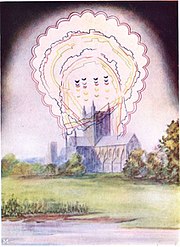
Plate M showing the form created by music of Mendelssohn "depicts yellow, red, blue and green lines rising out of a church." This, as the authors explain, "signifies the movement of one of the parts of the melody, the four moving approximately together denoting the treble, alto, tenor and bass respectively." Moreover, "the scalloped edging surrounding the whole is the result of various flourishes and arpeggios, and the floating crescents in the centre represent isolated or staccato chords."[85][note 47]
On Plate G depicts a musical form to the piece by Gounod.[87][note 48] Describing a musical form "created" by Wagner (on Plate W), the authors note in it the likeness to the "successively retreating" ramparts of a mountain, "and it is heightened by the billowy masses of cloud which roll between the crags and give the effect of perspective."[88][note 49][note 50]
Thought-Forms and modern arts[edit]

According to professor Ellwood, the book by Besant and Leadbeater had a large influence on modern art. "It suggested, to a world moving rapidly beyond the literalism of Victorian art, the expression in painting of surreal forms and forces underlying, but different from, the visible world."[92] Thought-Forms demonstrated how the symbolism of "astral colors and forms" can express the specificity of "certain soul's and mental states." It had a great influence on Kandinsky[93][19][note 52] as one of the essential factors that led to the "genius opening of new perspectives for painting."[96][note 53][note 54]
According to reminiscences by Sabaneyev, besides The Secret Doctrine Scriabin interested a magazine Vestnik Theosofii, which published [from 1908] the translations of Besant and Leadbeater's works.[99][100] Apparently, being impressed by theirs theosophical works, he once said that "strong, powerful thought creates a thought-form so intense that it, in addition to the will, flows into the consciousness of other people."[101][note 55] The perform of the part of light in Prometheus he imagined in the form of a radiance of some "luminous matter," which was supposed to fill the hall.[103][note 56][note 57]
A historian Breen wrote that Besant and Leadbeater were well aware how annoying stuff may be their book for a "society that remained deeply conservative." In early January 1901, when this book was published, "Queen Victoria still ruled England. 'Modernism' as a movement or even a concept did not exist. When we consider this world of 1901, – further wrote Breen, – it becomes difficult not to believe that Besant, Leadbeater and their milieu deserve a more prominent place in the annals of both abstract art and the history of modernism." As the art critic Kramer has pointed, "what is particularly striking about the outlook of the artists primarily responsible for creating abstraction is their espousal of occult doctrine."[76] Yeats, Eliot, Malevich, Kandinsky, and Mondrian were charmed by Theosophy.[note 58] In the first decades of the twentieth century, it was a widespread "component of Western cultural life."[106][note 59]
Thus, Besant and Ledbetter had played, summed up Breen, "a small but intriguing role in shaping the globalized culture... which weaves together East and West, mysticism and rationalism, sound and sight."[107][note 60]
See also: Synesthesia § Art
The Theosophical theory of sound[edit]

Prof. Iqbal Taimni wrote that the term Logos of a "manifested system", used in the Theosophical literature, is equivalent to the Hinduist concept Shabda Brahma, where Shabda means "sound" in its most broad meaning.[13][note 2] Hinduists claim that the first act of creation was the emergence of a "subtle sound vibration" that gave birth to all "forms of the material world". Each sound created a form, and "combinations of sound created complicated shapes".[15][note 3] The Secret Doctrine states, "Sound may be produced of such a nature that the pyramid of Cheops would be raised in the air".[17] The Instructions for the Esoteric Section of the Theosophical Society contain tables and diagrams of correspondence between the musical scale and other septenary principles of Theosophy.[1][18]
The Theosophists Annie Besant and Charles W. Leadbeater wrote that sounds and noises create in "matter" of the thin plane the "forms" visible to some people.[19] They argued also that whenever a "composer writes music", his emotions are reflected in the shape of "luminous projections" in his aura. They called these projections "thought-forms".[note 4] In the process of performing a composition, the musician also "expresses" his own emotions, which "produce other thought-forms". Moreover, the music itself produces "sound-forms", that may be called music-forms, which, although similar to thought-forms, are not them technically and, therefore, are not reflected in the aura, but they are projected, as musicologist Luciano Chessa noted, "onto the sky above the performance venue".[20][note 5][note 6]
Thought-forms are created also by hearers who react to "both the music and the [music] forms". In addition, the thought-forms of the performer and the hearers, as well as the sound-forms created by the music, arise simultaneously, although the thought-forms are not capable of influencing "more voluminous sound-forms". Besant and Leadbeater argued that, just as thought-forms correspond to thoughts and emotions, the characteristics of each music-form "correspond" to the elements of the music that gave rise to this form. For each "musical characteristic (harmony, melody, rhythmical articulation, form, timbre, etc.) there exist a corresponding form and color that render that characteristic with extraordinary precision." The size of music-form and the time it takes to stay in space varies depending on the "dynamics, timbre, quality of musical execution, and other parameters". The more the "spiritual" significance of music, the clearer, brighter and more voluminous its music-form. In addition, these forms emit vibrations in all directions throughout the "entire duration of their existence" (sometimes more than 2 hours). Thus, a musician, due to the vibrations of the music-form created by him, can influence, according to the Theosophists, many people, without meeting them on the physical plane.[24]
According to composer Kurt Leland, musical art can be called the "most Theosophical" of arts,[note 7] and "even without knowing" the three objectives of the Theosophical Society,[26] "composers and performers often promote them, and listeners experience their effects."[27] He wrote that one of the forms of world music, of particular interest to Theosophists, is kirtan, Indian religious singing of excerpts in Sanskrit which is considered to possess "great spiritual power". A leader sings a mantra, and the choir then repeats it. This enhances its spiritual significance, thus the music raises consciousness to "higher states".[28]




